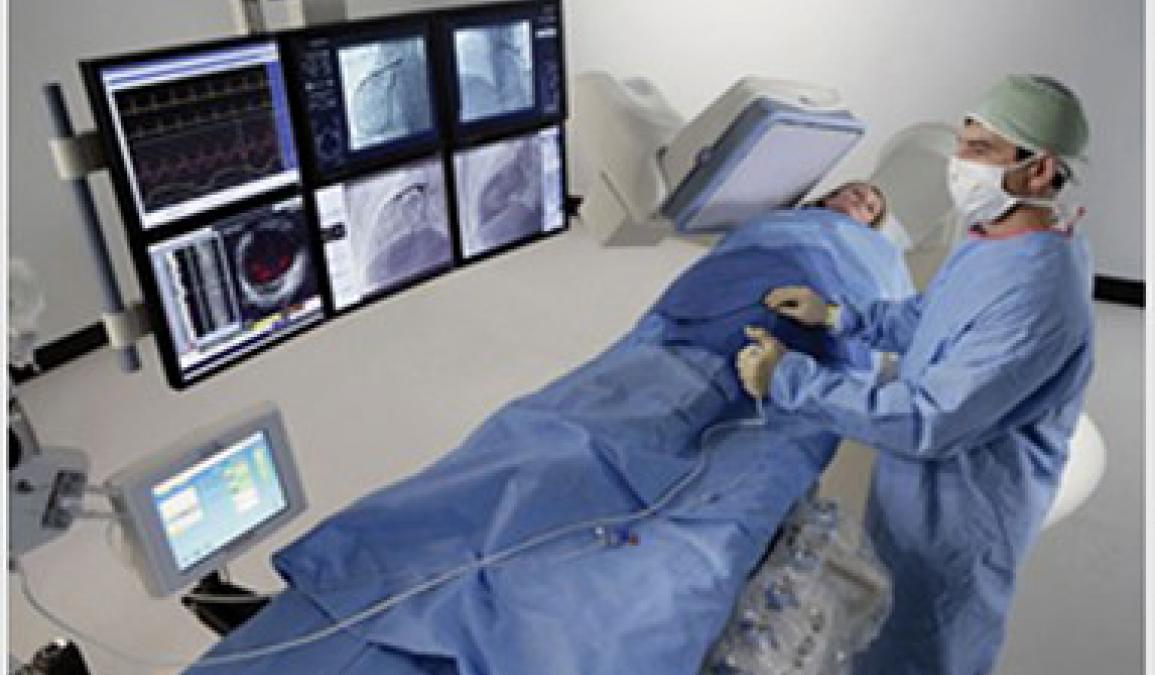
Interventional Cardiology
Last updated: 4/09/2020
Cardiovascular diseases are the leading cause of death in industrialized countries, both in men and women. The majority of cardiovascular deaths are due to atherosclerosis of the coronary arteries narrowing or occluding the lumen of these vessels. Until 1977, only "bridging" allowed revascularization of the heart muscle, but at the cost of heavy surgery.
Diagnostic Tests
Several "non-invasive" tests can be used to detect coronary artery disease (cardiac scan) or to evaluate its functional impact (stress test, stress echocardiography, myocardial scintigraphy, cardiac magnetic resonance imaging).
However, only coronary angiography makes it possible to specify with certainty the existence and extent of coronary disease and to decide on the treatment, each specific situation being discussed between the medical team and the patient. Most often percutaneous coronary intervention is performed in the same session.
Coronary Angiography
Coronary angiography is a radiological examination of the coronary arteries.
A very small tube (catheter) is introduced into a peripheral artery. The end of the tube is positioned at the origin of the arteries irrigating the heart and a special liquid (contrast product) is injected. This liquid is visible on X-rays.
At Aboujaoudé Hospital, the vast majority of diagnostic coronary angiography is performed radially, which allows the patient to be immediately lifted and returned home the same day.
Percutaneous Coronary Intervention
Currently, the majority of coronary angiography leads to percutaneous coronary intervention, also known as angioplasty or coronary dilation. Percutaneous coronary intervention is a very effective treatment of coronary disease. More than one million percutaneous coronary interventions are performed annually worldwide. Percutaneous coronary intervention is an intervention using catheters and performed by an interventional cardiologist to restore blood flow through a narrowed or occluded coronary artery. It is for many years the most used myocardial revascularization technique. It is less aggressive, less costly and quicker to perform than bridging surgery, with the patient usually returning home the next day. Angioplasty is performed in a programmed manner to treat coronary artery disease, but also urgently to treat a myocardial infarction.
A thin tube, with a balloon at its extremity, is first advanced in an artery of the groin or wrist to the site of the narrowing or coronary occlusion. Once in place, the balloon is then inflated to push the plaque and the artery wall outward, enlarging the artery and restoring the blood flow. Then all the angioplasty equipment is removed.
In almost all cases today, a metal prosthesis, the stent, is also used, directly or after coronary angioplasty. Unlike the balloon, the expanded stent remains in place, serving as a permanent internal tutor to the newly enlarged artery.

Stents have led to the virtual disappearance of acute coronary angioplasty complications, in particular, acute coronary dissection occlusion, postoperative myocardial infarction and emergency coronary artery bypass surgery. They also halved recurrence (restenosis) and re-intervention within 6 to 12 months after angioplasty.
More recently, active drug release stents have become the most widely used stents around the world. These prostheses locally release a small amount of drug during the weeks following their implantation in order to prevent the growth of scar tissue inside the prosthesis and a new obstruction of the artery. Active stents again reduced the re-stenosis rate (re-obstruction) to 5%. These new stents require prolonged double antiplatelet therapy after surgery, usually for at least one year.
At Aboujaoudé Hospital, all techniques of percutaneous coronary intervention are available, in particular, the Japanese guides specific for chronic coronary occlusions, thrombo-aspirating catheters (in emergency myocardial infarction), the cutting balloon, Rotary atherectomy strains, and of course circulatory assistance by intra-aortic balloon counter-pulsation for cardiogenic shock states. These techniques now make it possible to address increasingly complex lesions (left coronary trunk, complex bifurcations, chronic occlusions, diffuse lesions, etc.).
At Aboujaoudé Hospital, the permanent presence of an anaesthesiologist-resuscitator administering conscious sedation avoids any pain or anxiety of the patient and allows the cardiologist to concentrate.
Percutaneous intracardiac interventions
In hypertrophic cardiomyopathies, septal ablation by alcohol injection in septal arteries provides an excellent therapeutic alternative to surgical myectomy.
The percutaneous closure of the permeable foramen ovale or inter-auricular communication is a simple and effective treatment for the appropriate candidates.
Percutaneous aortic valve replacement is for the most common valvular heart disease. Currently reserved for patients with high surgical risk, it could quickly become the treatment of choice of aortic valvular stenosis of the elderly.
Finally, the percutaneous repair of the mitral valve is only in its infancy.
Peripheral vascular procedures and the thoracic and abdominal aorta
They are performed by the interventional vascular radiologists and the vascular surgeons of Aboujaoudé Hospital.
Peripheral vascular procedures and the thoracic and abdominal aorta
They are performed by the interventional vascular radiologists and the vascular surgeons of Aboujaoudé Hospital.
Conclusion
Created 12 years ago, Aboujaoudé Hospital Department of Interventional Cardiology allows patients with cardiovascular diseases to benefit from the most modern diagnostic and interventional invasive techniques.